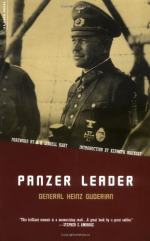
|
| Name: _________________________ | Period: ___________________ |
This test consists of 15 multiple choice questions and 5 short answer questions.
Multiple Choice Questions
1. What caused problems in the repair and maintenance of tanks in 1943?
(a) Allied bombing.
(b) Lack of trained personnel.
(c) Constant modifications to tank designs.
(d) Lack of strategic resources.
2. What was the code name for the German invasion of Russia?
(a) Downfall.
(b) Sea lion.
(c) Barbarossa.
(d) Overlord.
3. By December of 1941, what hazard killed more German soldiers than enemy action?
(a) Malaria.
(b) Frostbite.
(c) Trench-foot.
(d) Dysentery.
4. What type of vehicle was the Panther?
(a) A tank-destroyer.
(b) An armored personnel carrier.
(c) A heavy tank.
(d) A light tank.
5. How many Panzer divisions were formed by 1935?
(a) Twelve.
(b) Three.
(c) Ten.
(d) Seven.
6. Why did Guderian believe the French wanted to avoid real fighting?
(a) They did not attack while Germany invaded Poland.
(b) They were dug in and defending.
(c) They lacked of offensive weapons.
(d) They were traditionally averse to conflict.
7. What nation used tanks in WWI?
(a) France.
(b) England.
(c) Austria.
(d) Germany.
8. What was the first city that Guderian attacked in France?
(a) Chaumont.
(b) Metz.
(c) Bouillon.
(d) Strasbourg.
9. Why did Guderian accept the new post offered to him after the occupation of the Sudetenland?
(a) Honor and pride demanded he accept.
(b) The position opened more options for promotion.
(c) The position gave him access to more resources.
(d) Hitler insisted he accept.
10. Where did Guderian see and drive his first tank?
(a) Denmark.
(b) England.
(c) Sweden.
(d) Austria.
11. Why did Hitler feel it was reasonable to occupy the Sudetenland?
(a) There was a large German population there.
(b) The current ruler was an internationally unloved dictator.
(c) The occupation would require little violence.
(d) The region was home to failed states.
12. Why was Guderian removed from his command by von Kluge?
(a) He ordered a withdrawal.
(b) He bungled an offensive.
(c) He disobeyed a direct order from Hitler.
(d) He lost most of his tanks in a pitched battle.
13. What rank did Guderian achieve in 1938?
(a) Field Marshal.
(b) General.
(c) Major General.
(d) Lieutenant General.
14. When was the Sudetenland incorporated into Germany?
(a) October 1938.
(b) June 1938.
(c) September 1939.
(d) March 1939.
15. How many children did Guderian have?
(a) Three daughters.
(b) A son and a daughter.
(c) Two sons.
(d) Two sons and a daughter.
Short Answer Questions
1. What did Guderian not like about the post that was offered to him after the occupation of the Sudetenland?
2. What was one difficulty that Guderian's forces encountered during the march into Austria?
3. When did the "Breakthrough to the Channel" begin?
4. What prevented Guderian from taking advantage of his right to choose property in Germany?
5. How did the first waves of the 10th Panzer Division cross the Meuse River?
|
This section contains 483 words (approx. 2 pages at 300 words per page) |

|




